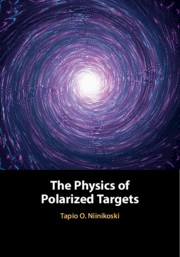Book contents
- The Physics of Polarized Targets
- The Physics of Polarized Targets
- Copyright page
- Dedication
- Contents
- Preface
- Acknowledgements
- 1 Introduction to Spin, Magnetic Resonance and Polarization
- 2 Resonance and Relaxation of Interacting Spin Systems
- 3 Electron Paramagnetic Resonance and Relaxation
- 4 Dynamic Nuclear Polarization
- 5 Nuclear Magnetic Resonance and Relaxation
- 6 NMR Polarization Measurement
- 7 Polarized Target Materials
- 8 Refrigeration
- 9 Microwave and Magnet Techniques
- 10 Other Methods of Nuclear Spin Polarization
- 11 Design and Optimization of Polarized Target Experiments
- Appendices
- Index
- References
11 - Design and Optimization of Polarized Target Experiments
Published online by Cambridge University Press: 03 February 2020
- The Physics of Polarized Targets
- The Physics of Polarized Targets
- Copyright page
- Dedication
- Contents
- Preface
- Acknowledgements
- 1 Introduction to Spin, Magnetic Resonance and Polarization
- 2 Resonance and Relaxation of Interacting Spin Systems
- 3 Electron Paramagnetic Resonance and Relaxation
- 4 Dynamic Nuclear Polarization
- 5 Nuclear Magnetic Resonance and Relaxation
- 6 NMR Polarization Measurement
- 7 Polarized Target Materials
- 8 Refrigeration
- 9 Microwave and Magnet Techniques
- 10 Other Methods of Nuclear Spin Polarization
- 11 Design and Optimization of Polarized Target Experiments
- Appendices
- Index
- References
Summary
The figure of merit is defined for some scattering applications; this figure permits the objective comparison of the various target types and polarization methods. The optimization of the polarized target operation in particle physics experiments is briefly discussed before treating the sources of possible false asymmetries due to the target. Finally a series of uses of polarized target techniques beyond particle and nuclear physics experiments is presented. These include notably the coherent small-angle neutron scattering (SANS) used in the studies of biological macromolecules, time–resolved SANS, pseudomagnetism, nuclear magnetic ordering, DNP enhancement of high-resolution NMR spectroscopy, particularly in solid state using the magic angle spinning techniques. The sensitivity and contrast enhancement are briefly discussed for magnetic resonance imaging (MRI) techniques. These use various DNP techniques and radical-free injectable polarized fluid methods, as well as the dissolution DNP techniques.
Keywords
Information
- Type
- Chapter
- Information
- The Physics of Polarized Targets , pp. 436 - 470Publisher: Cambridge University PressPrint publication year: 2020
